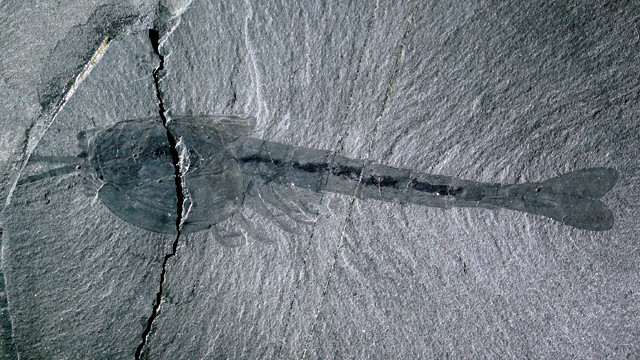
by Lucas Joel Tuesday, July 3, 2018

Exquisitely preserved fossils of Waptia fieldensis can be found in Canada's Burgess Shale. Credit: Susan Butts/Yale University.
The exquisitely preserved fossils found in the 500-million-year-old Burgess Shale in Canada are famous for the detailed anatomy they display. They also provide a rare and crucial record of the Cambrian Explosion, when most of the major animal groups first appeared.
The exact conditions that contributed to such robust fossil preservation are still largely unknown. In life, the animals were soft-bodied, and soft-bodied animals usually decay after they die, making them less likely to be preserved and represented in the rock record. Many Burgess fossils, however, are exceptions. “We really want to know: Why does this happen? What’s so good about this place for preserving those decay-prone parts of the organisms?” says paleontologist Ross Anderson of Yale University.
In a new study in Geology, Anderson and his colleagues report a new clue they recently unearthed: an iron-rich clay mineral, berthierine, that’s common in the rocks that encase the Burgess fossils. The discovery of a “mineral fingerprint” could explain the secret to Burgess-type fossils, Anderson says.
The researchers wondered if certain minerals in ocean sediments play a role in inhibiting postmortem decay of marine animals. They started looking for a mineral fingerprint, first delving into the topic in 2016 in an earlier study in Geology; they found that berthierine does indeed inhibit the growth of a bacterium involved in the decay of marine animals.
The next step was to find out if the Burgess Shale fossils contained the same mineral, so Anderson and his colleagues tested samples from the Burgess as well as from similar fossil sites around the world. They found that rocks bearing Burgess-type fossils all contain berthierine — which was found to make up between 10 and 20 percent of the rock.
But while the mineral may be a marker for sites of soft-bodied fossil preservation, it likely didn’t have a direct role in the fossilization process, says Robert Gaines, a paleontologist at Pomona College in California and a co-author of the new paper. “These are clays that form in the early burial environment [after the animal was fossilized] — thus, there is no role for original [berthierine] mineralogy in causing fossilization,” Gaines says.
It is possible that the mineralogical fingerprint could be a reflection of other factors, like the unique chemistry of the oceans at the time, says Emma Hammarlund, a geobiologist at Lund University in Sweden who was not involved in the new study. However, she says, having a rock characteristic that can be linked to the potential presence of well-preserved fossils is “a sweet first step” toward helping researchers find similar fossils in rocks elsewhere. Such finds, Anderson explains, could fill in gaps in our understanding of early animal evolution around the time of the Cambrian Explosion.
Anderson adds that there could be applications for the fingerprint beyond Earth. The Curiosity rover, which is trekking across Mars, has tools to assess mineralogy, he says, and Mars has plenty of clay. If the rover unearths berthierine, or something similar, it may be a first step toward detecting evidence of extraterrestrial life.
© 2008-2021. All rights reserved. Any copying, redistribution or retransmission of any of the contents of this service without the expressed written permission of the American Geosciences Institute is expressly prohibited. Click here for all copyright requests.